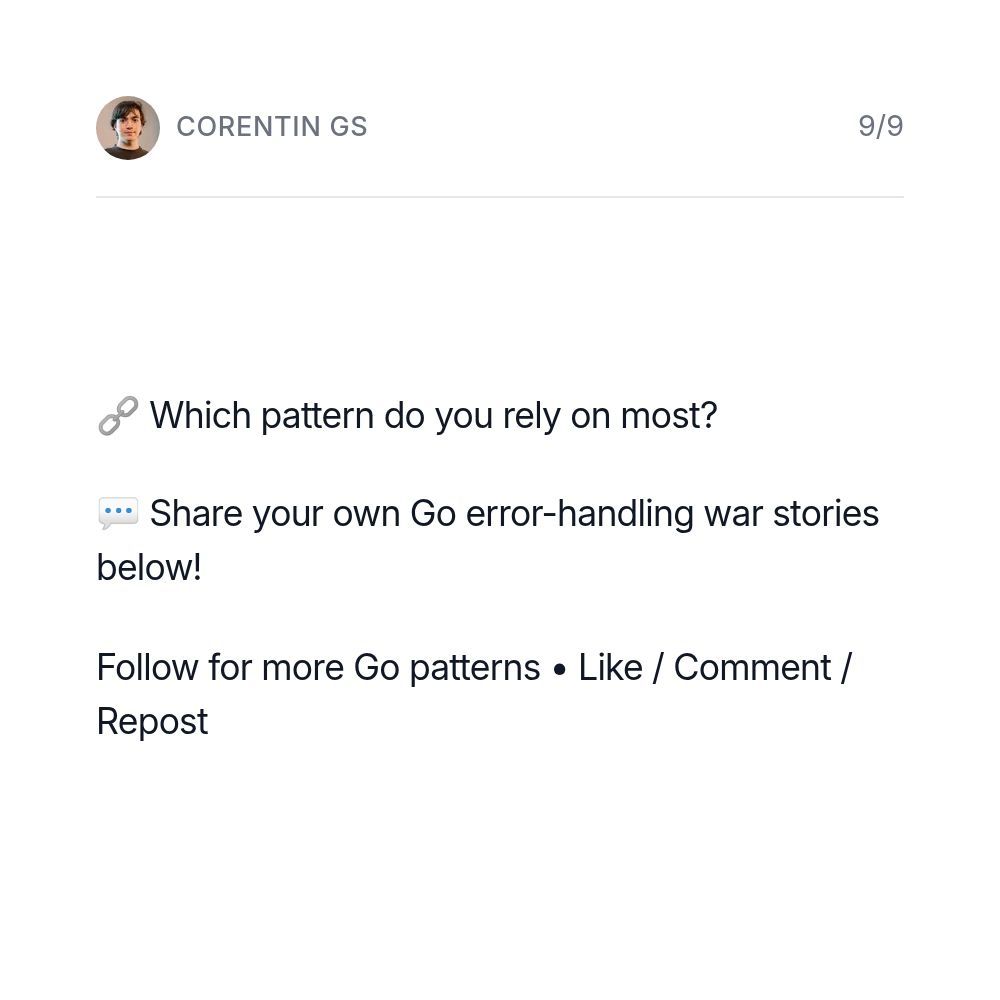
2. Custom Error Types Pattern: Attach rich context via structs. Use case: Precise HTTP-status mapping, structured logs, Sentry tags.
14.07.2025 09:18 — 👍 1 🔁 0 💬 1 📌 0@corentings.dev.bsky.social
Teaching Go for cloud-native microservices to backend beginners. Self-taught developer with 5 years of experience. Making the practical course I wish existed.

2. Custom Error Types Pattern: Attach rich context via structs. Use case: Precise HTTP-status mapping, structured logs, Sentry tags.
14.07.2025 09:18 — 👍 1 🔁 0 💬 1 📌 0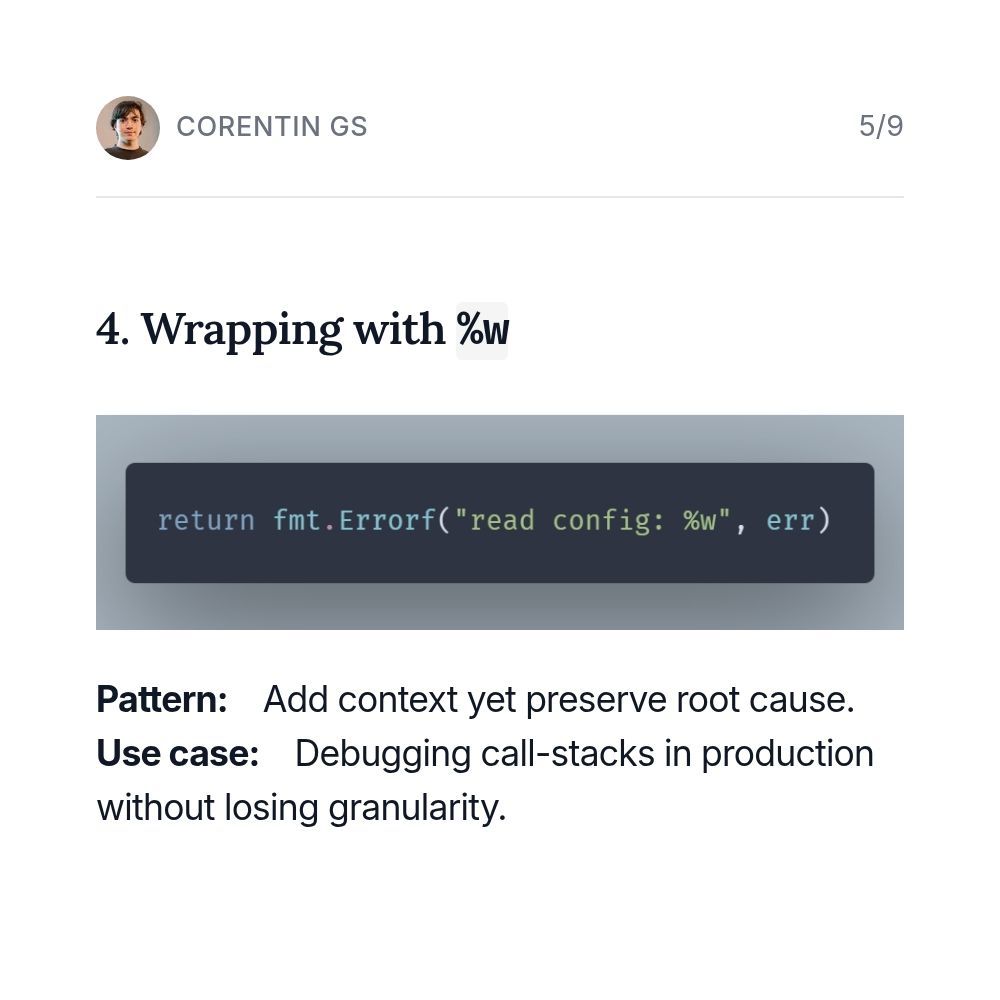
1. Error-as-Value (Idiomatic Go) Pattern: Return error as a normal value. Why it matters: Prevents panics and keeps control flow explicit in micro-services.
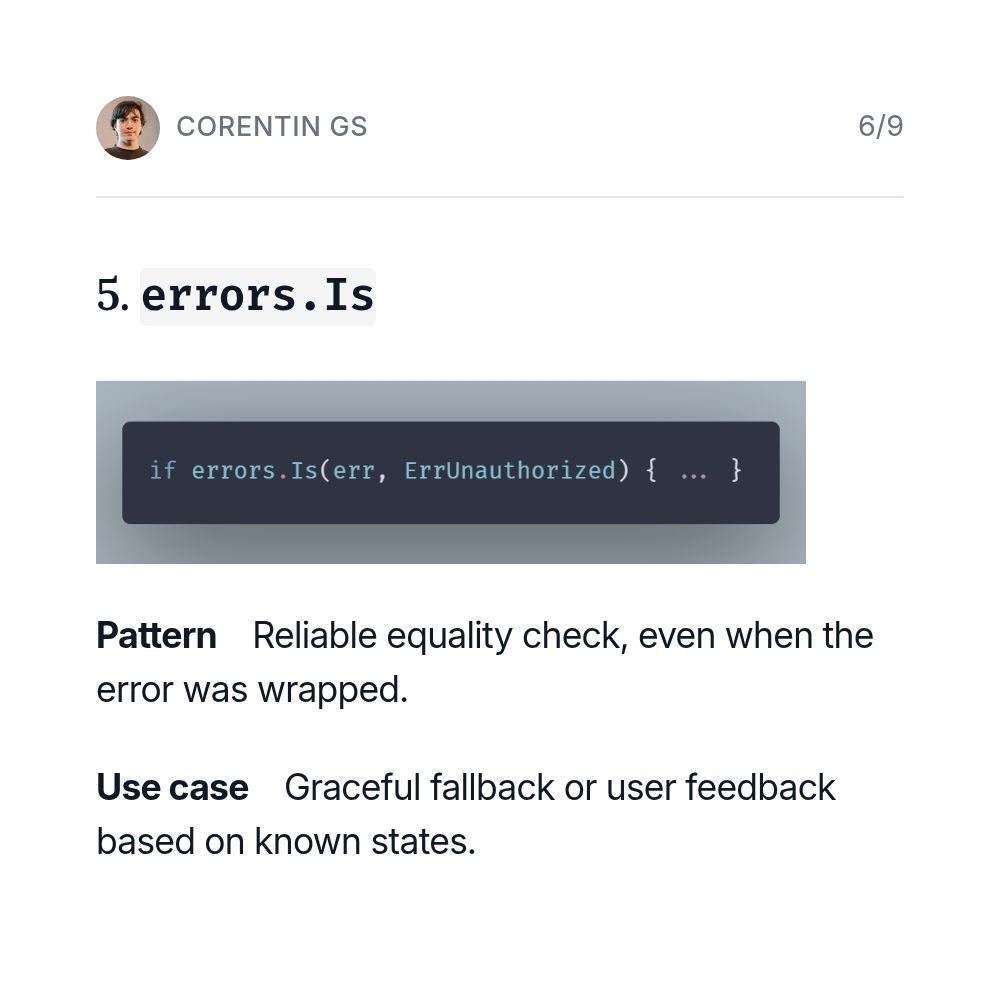
1. Error-as-Value (Idiomatic Go) Pattern: Return error as a normal value. Why it matters: Prevents panics and keeps control flow explicit in micro-services.
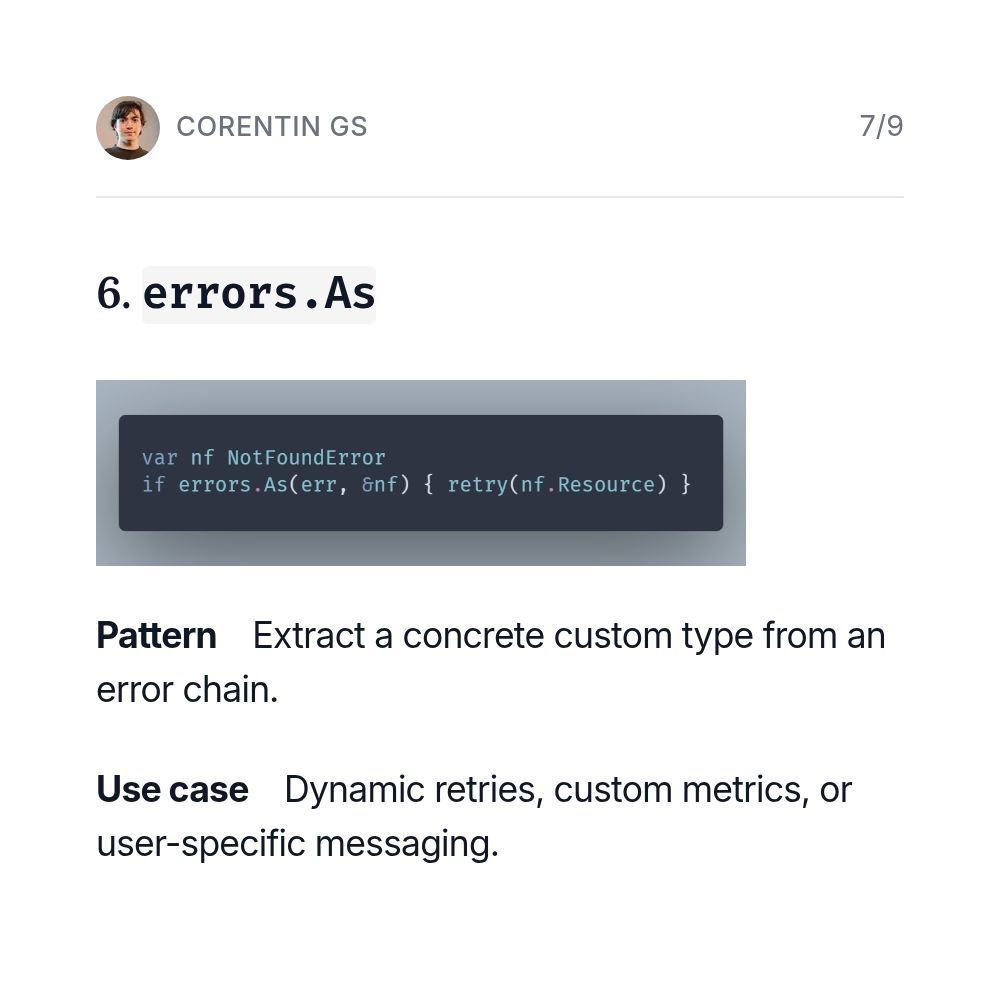
1. Error-as-Value (Idiomatic Go) Pattern: Return error as a normal value. Why it matters: Prevents panics and keeps control flow explicit in micro-services.
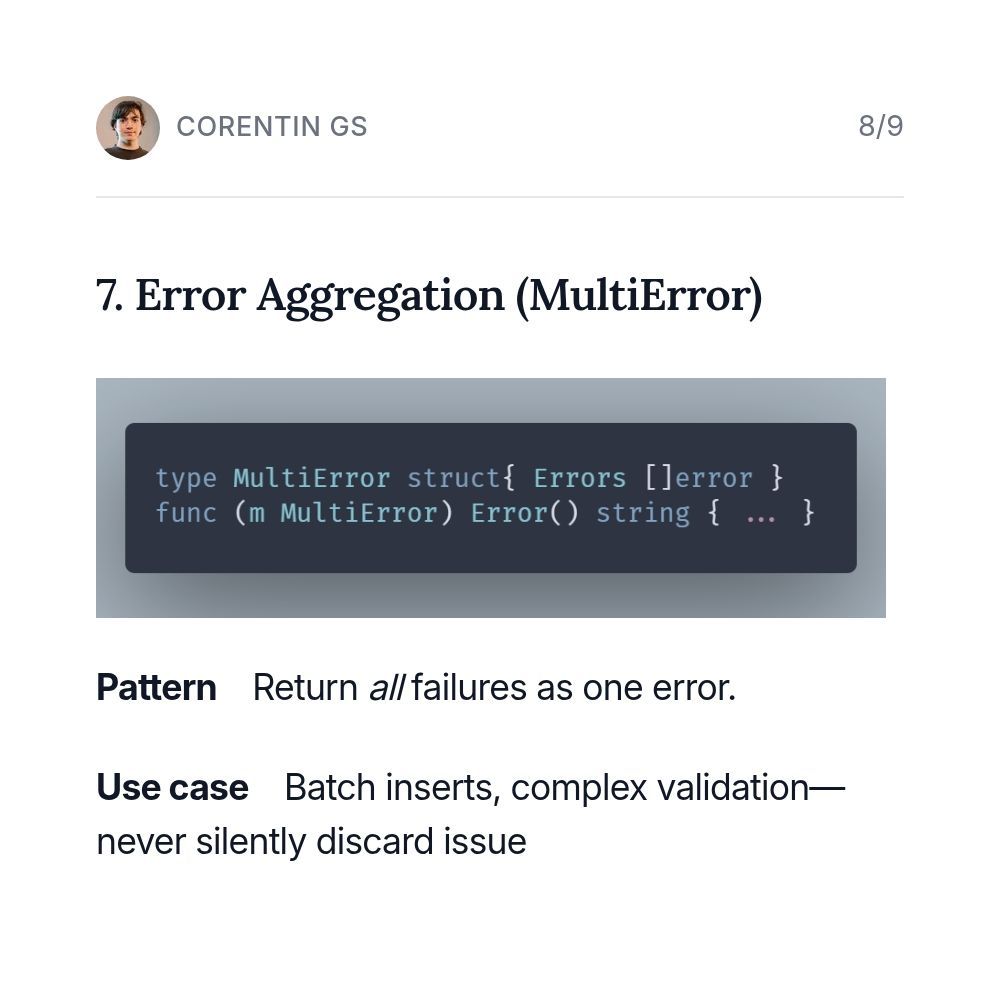
1. Error-as-Value (Idiomatic Go) Pattern: Return error as a normal value. Why it matters: Prevents panics and keeps control flow explicit in micro-services.
14.07.2025 09:18 — 👍 1 🔁 0 💬 1 📌 0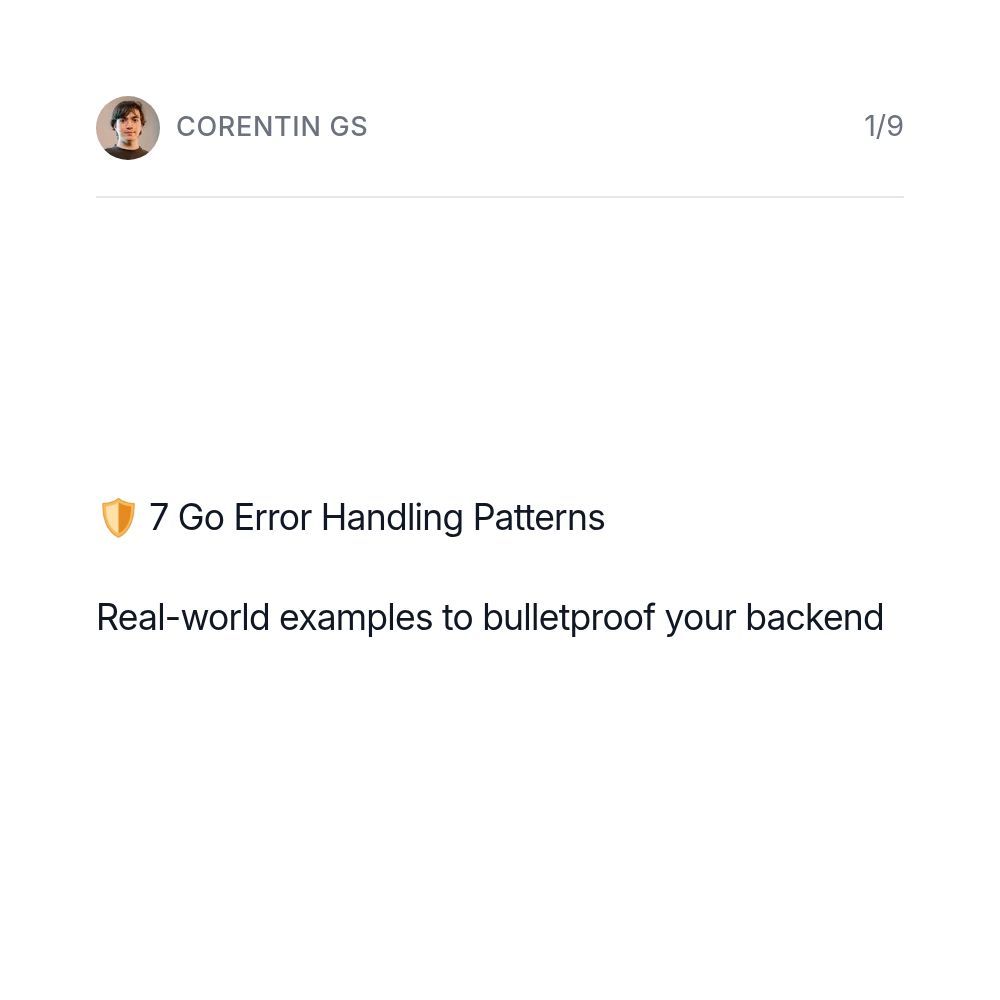
🛡️ 7 Go Error Handling Patterns Real-world examples to bulletproof your backend
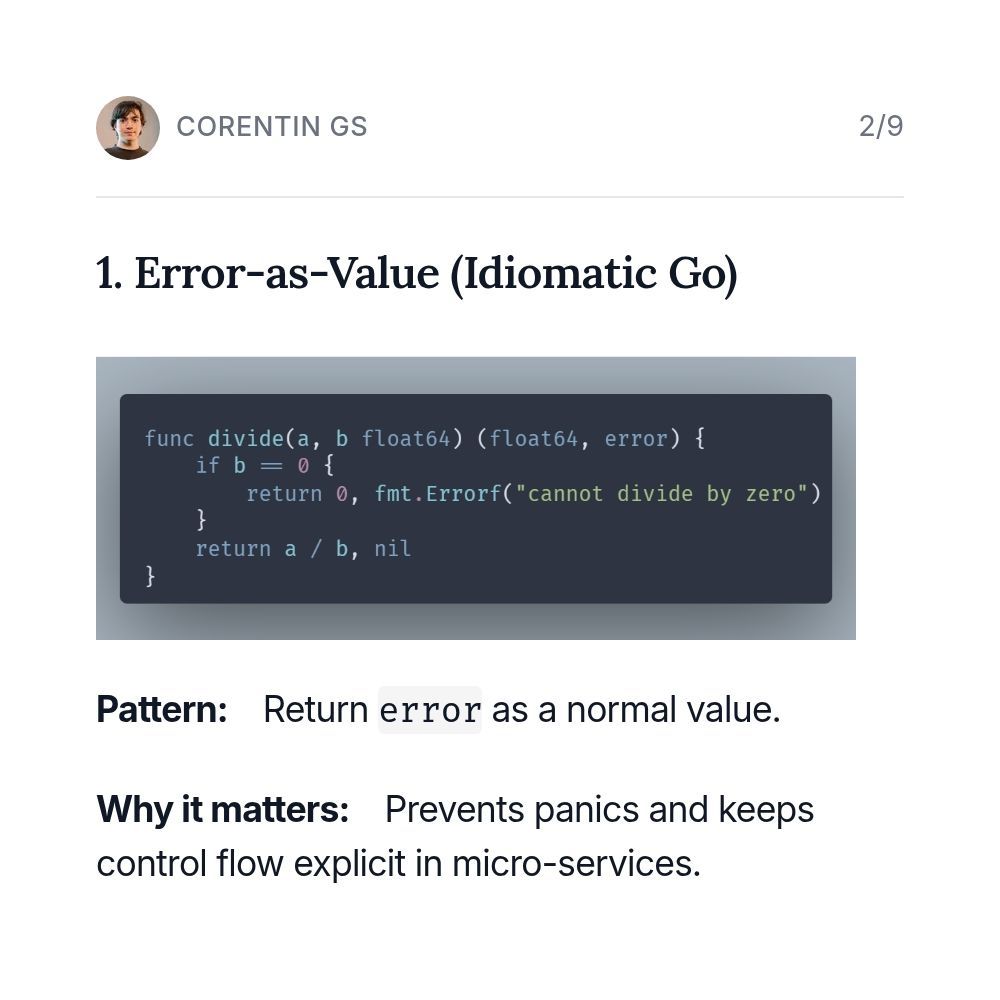
🛡️ 7 Go Error Handling Patterns Real-world examples to bulletproof your backend
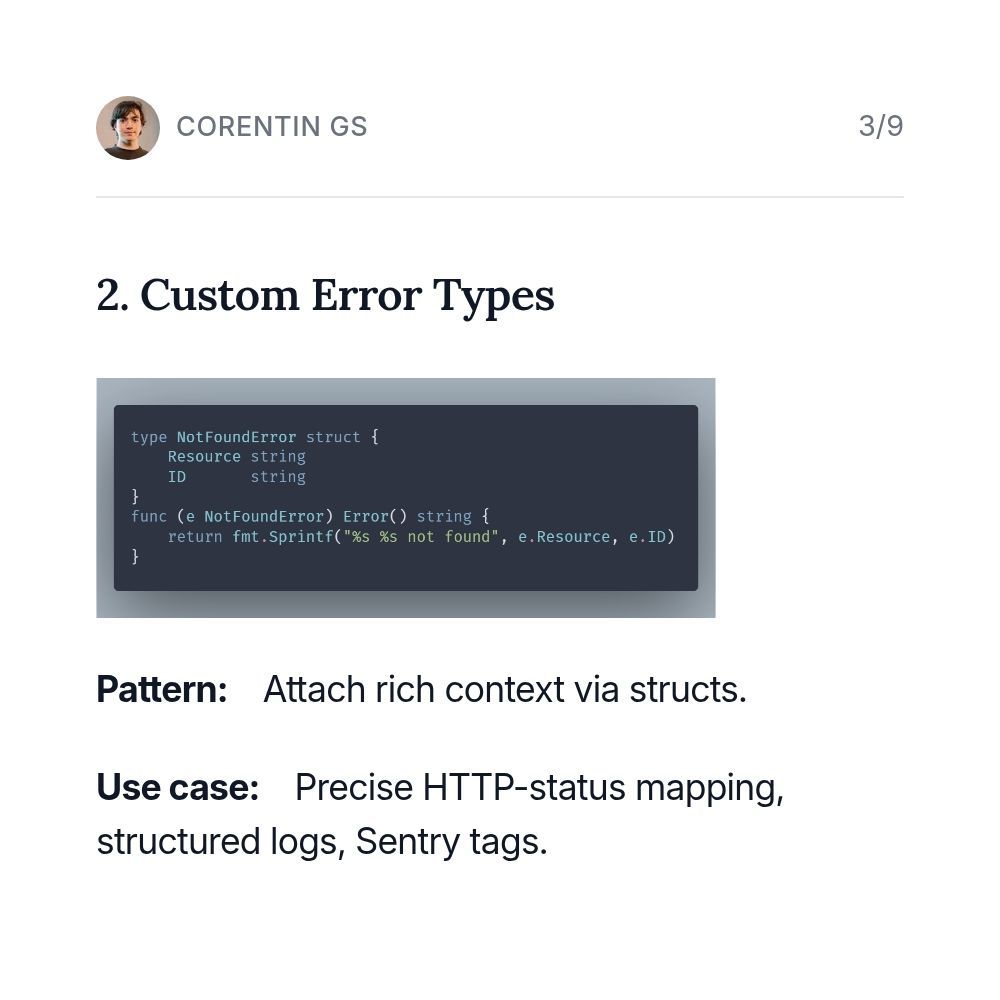
🛡️ 7 Go Error Handling Patterns Real-world examples to bulletproof your backend
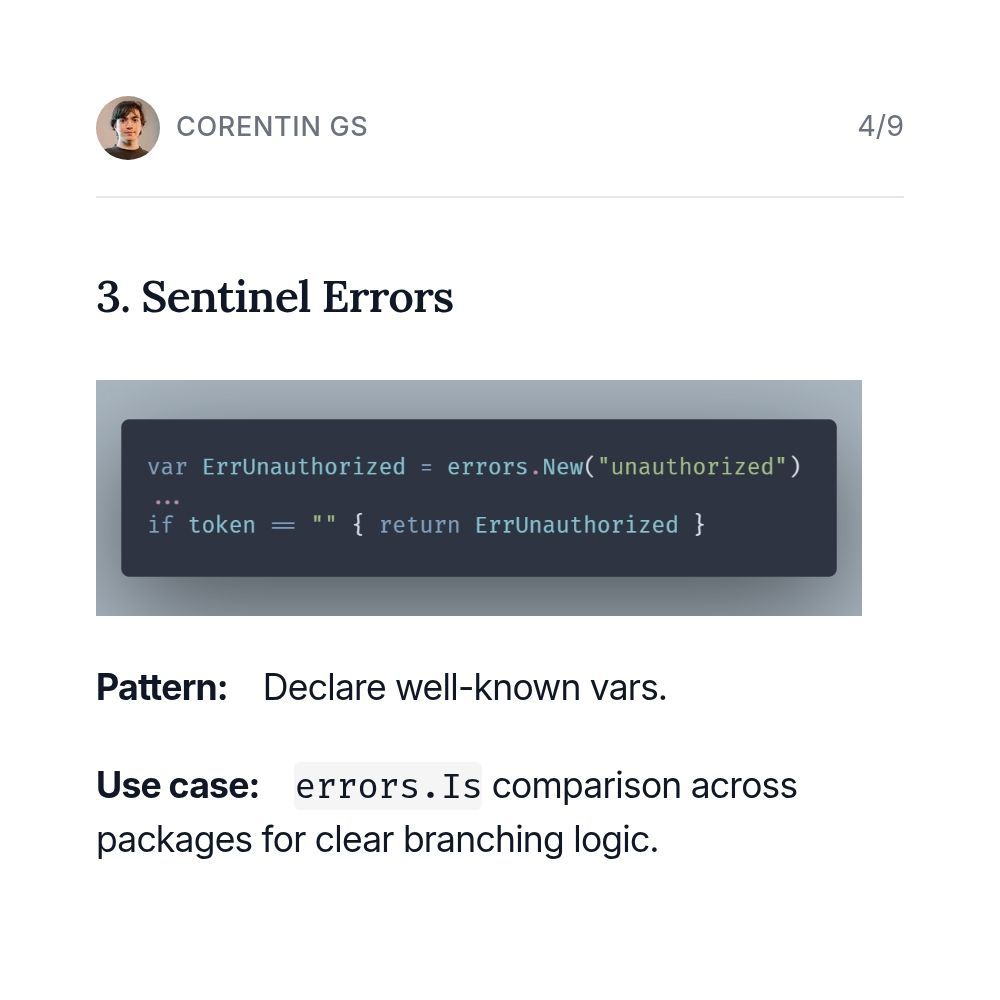
🛡️ 7 Go Error Handling Patterns Real-world examples to bulletproof your backend
Go error handling is often criticized for being “too verbose.”
Swipe the carousel to see why that criticism misses the point.
#Golang #Go
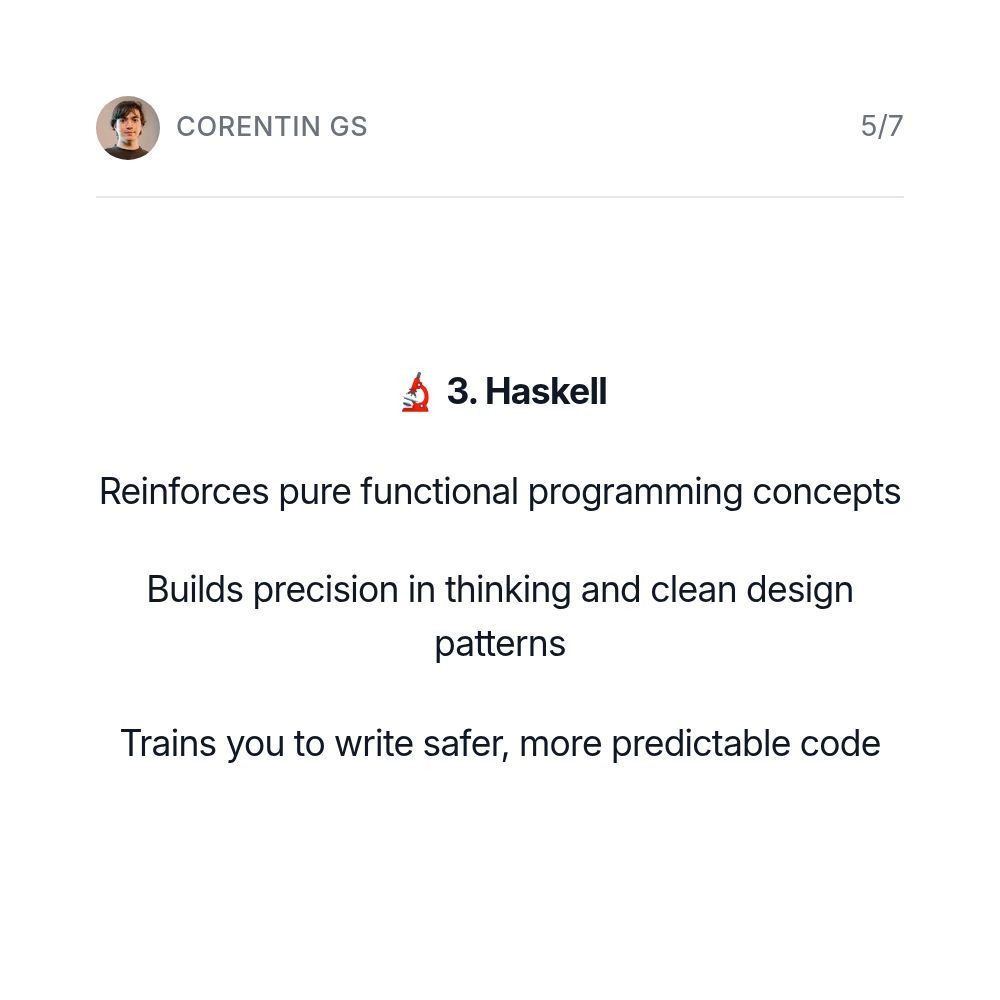
👨💻 Why focus on these languages? If you want to build a strong foundation as a software engineer, learning languages that teach core computer science concepts is crucial.
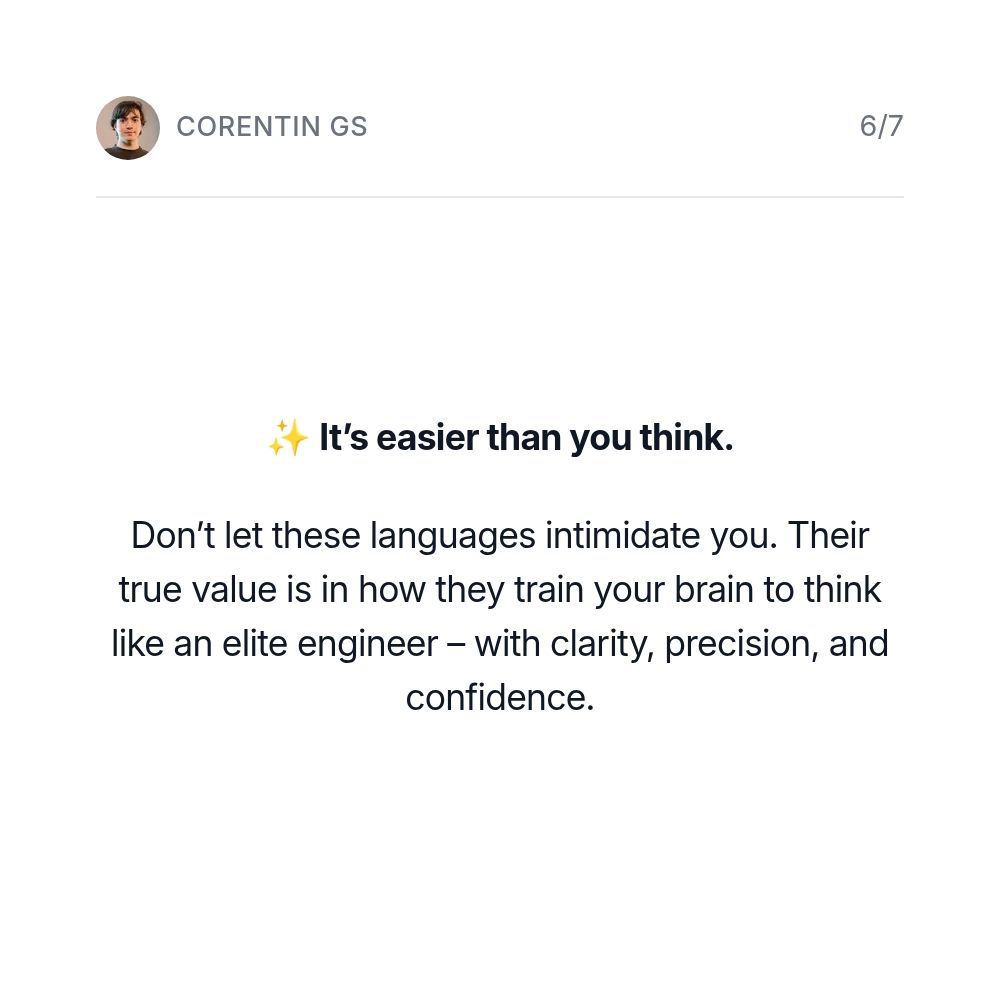
👨💻 Why focus on these languages? If you want to build a strong foundation as a software engineer, learning languages that teach core computer science concepts is crucial.
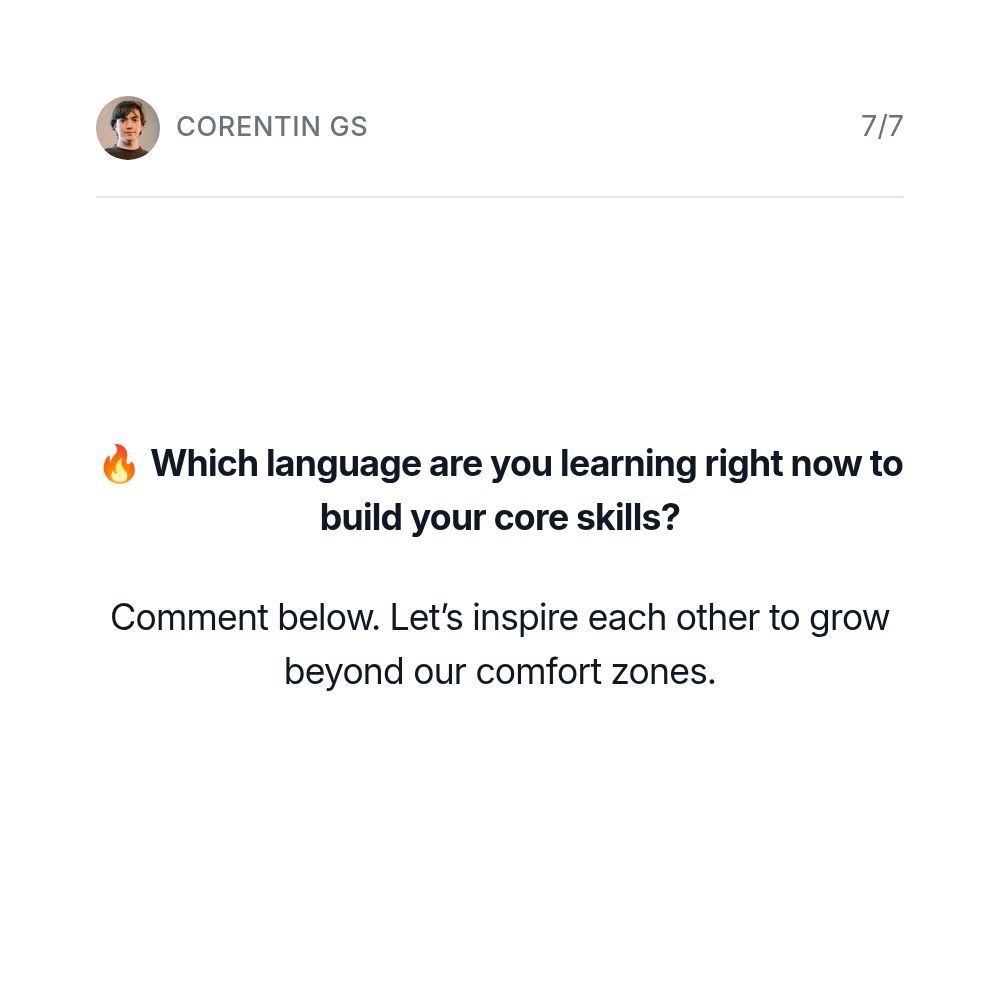
👨💻 Why focus on these languages? If you want to build a strong foundation as a software engineer, learning languages that teach core computer science concepts is crucial.
01.07.2025 16:00 — 👍 2 🔁 0 💬 0 📌 0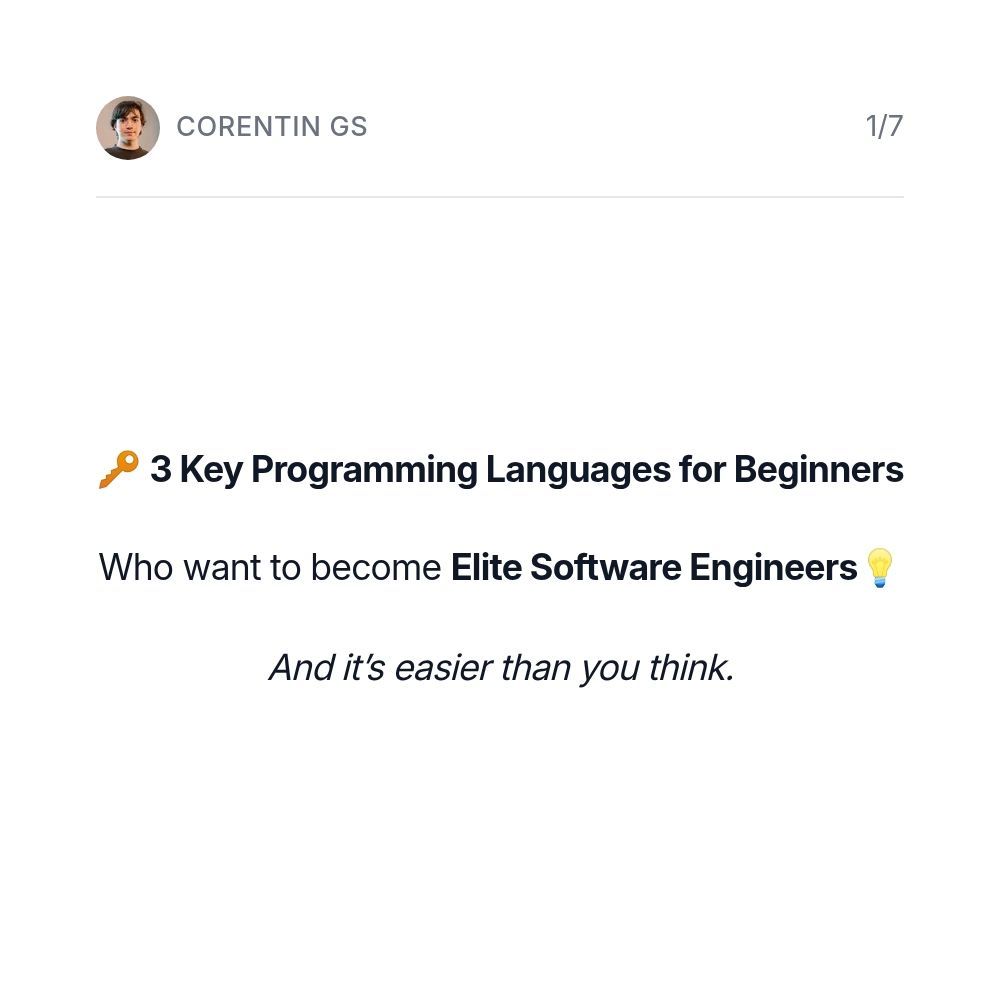
🔑 3 Key Programming Languages for Beginners Who want to become Elite Software Engineers💡 And it’s easier than you think.
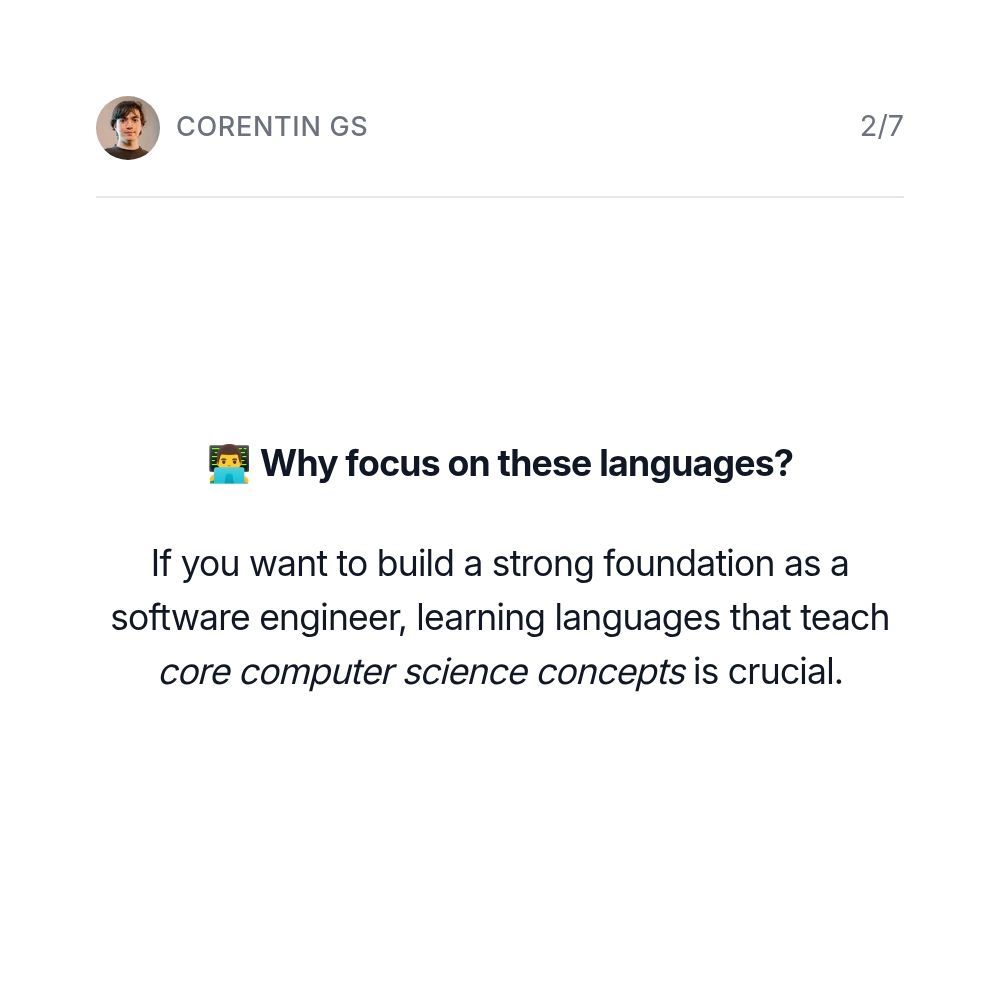
🔑 3 Key Programming Languages for Beginners Who want to become Elite Software Engineers💡 And it’s easier than you think.
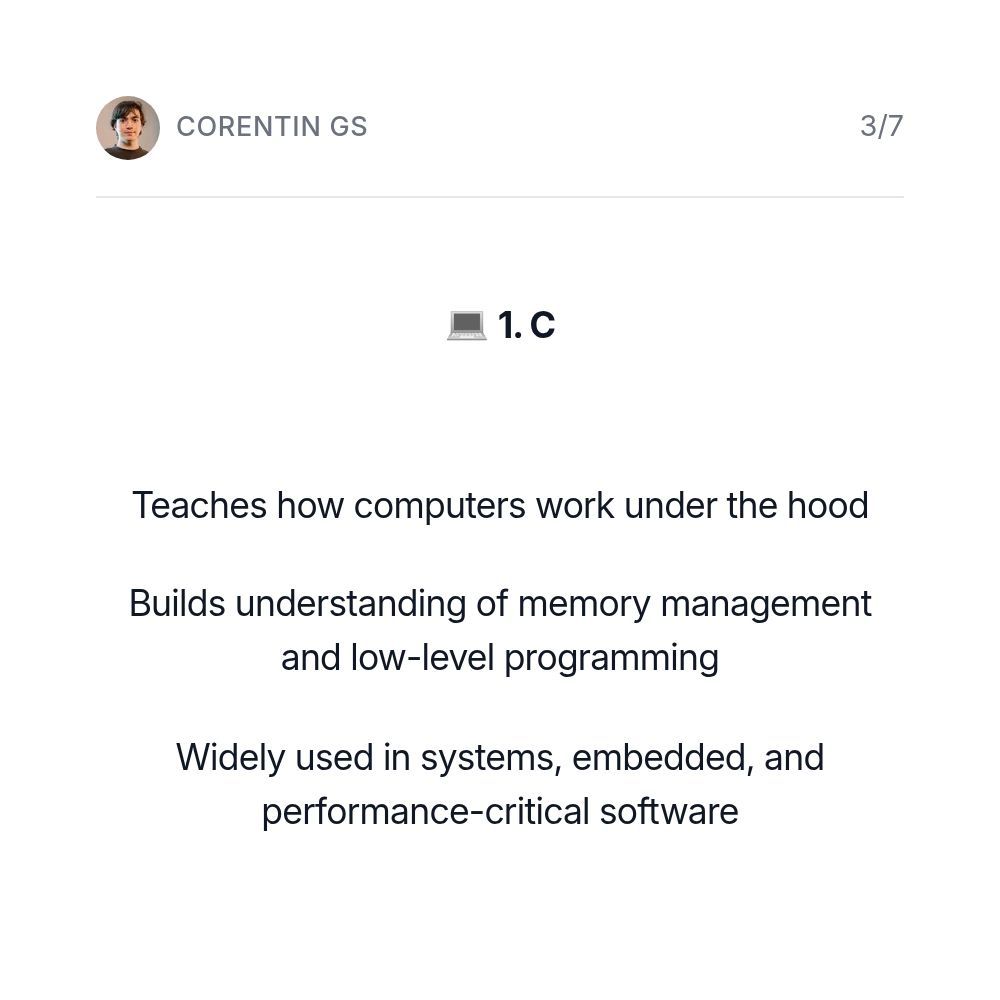
🔑 3 Key Programming Languages for Beginners Who want to become Elite Software Engineers💡 And it’s easier than you think.
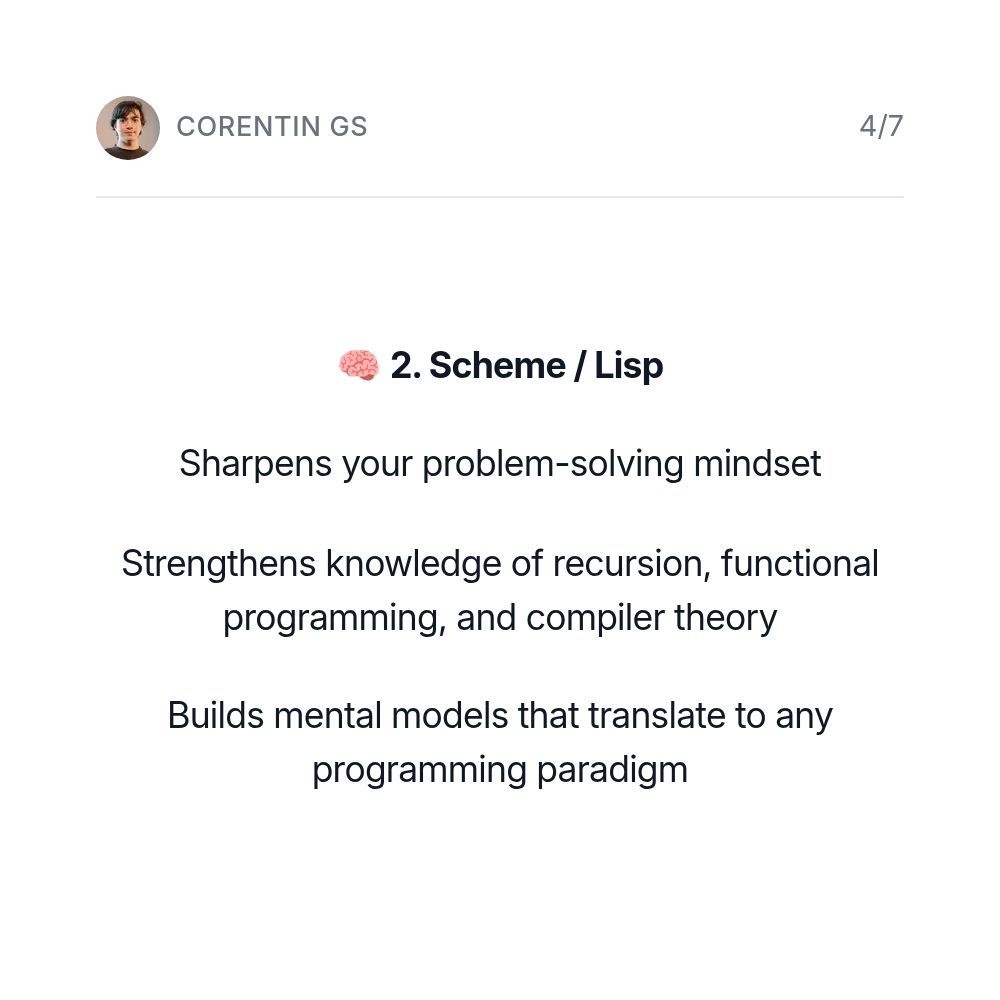
🔑 3 Key Programming Languages for Beginners Who want to become Elite Software Engineers💡 And it’s easier than you think.
These languages won’t get you a dev job tomorrow.
But they’ll teach you how to think, adapt, and face any coding challenge.
Hardcore? Sure.
But you don’t become a Jedi without sacrifice.
#Programming #CodeNewbie #LearnToCode #SoftwareEngineering
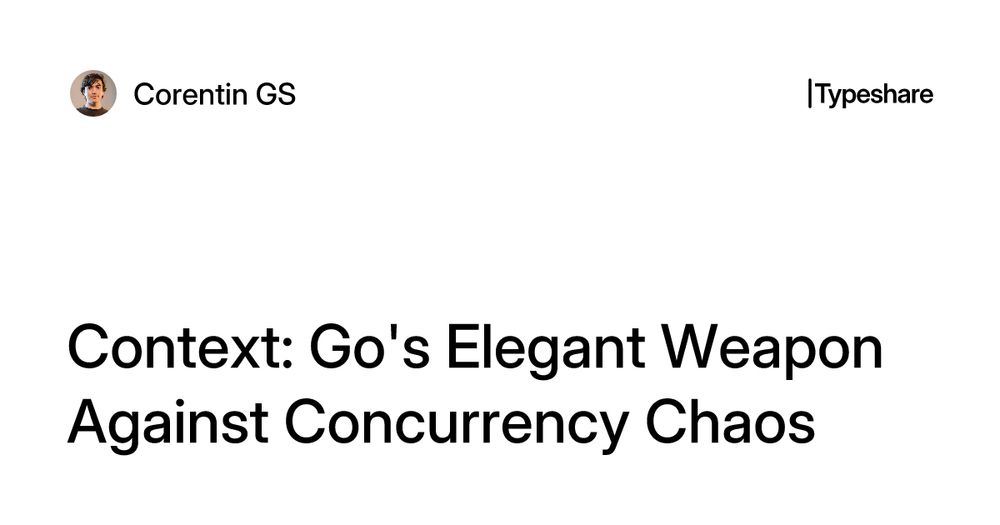
Read this and more on my Typeshare Social Blog: https://typeshare.co/corentings/posts/context-gos-elegant-weapon-against-concurrency-chaos-f0amr
04.06.2025 08:00 — 👍 1 🔁 0 💬 0 📌 0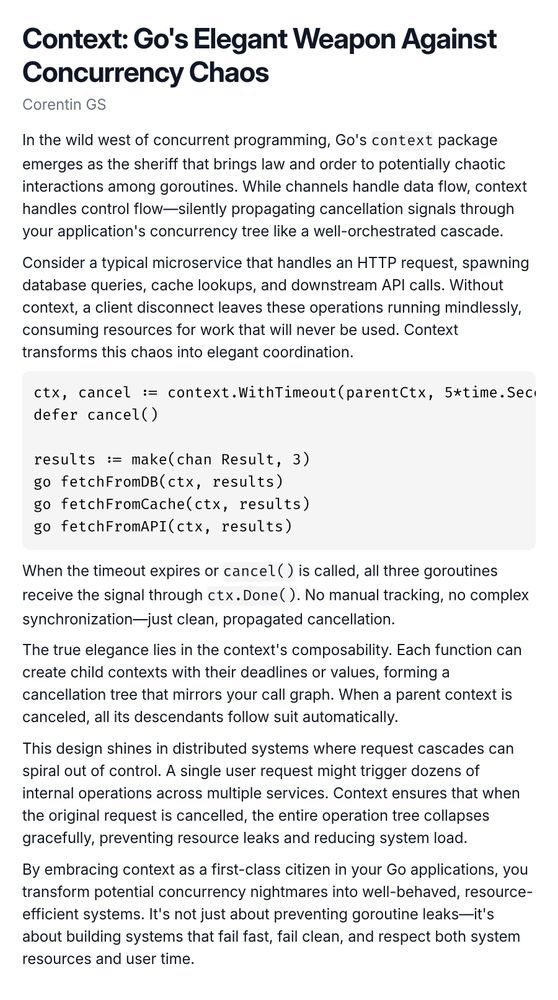
Screenshot essay titled 'Context: Go's Elegant Weapon Against Concurrency Chaos', discussing the importance of the Go programming language's context package in managing concurrency. The essay describes how context helps coordinate goroutines by propagating cancellation signals, using an example of a microservice handling HTTP requests. It details a code snippet demonstrating the use of context with timeout and how goroutines cleanly handle cancellation. The text emphasizes context's composability and its role in preventing resource leaks in distributed systems. The overall message encourages the adoption of context in Go applications to create efficient and responsive systems.
How Go's context package transforms chaotic goroutine sprawl into orchestrated control flow. From resource leaks to graceful cascading cancellations—context is the unsung hero of distributed Go systems.
#golang #programming
DDD isn’t an architecture. It’s a mindset.
• Business logic becomes clear
• Code reads like user stories
• Bugs get squashed fast
• Features map to reality
It’s the difference between organizing code vs. understanding the business.
#cleancode
If you’re still scattering business logic across 15 files…
Read this.
DDD means:
• Business in one place
• Fewer bugs
• Clearer features
• Faster onboarding
It changed how I code and think.
#ddd
MVC shows you where to put code.
DDD shows you what it should say.
• One place for business logic
• Domain-first thinking
• Less glue code, more clarity
I’d trade 5 years of patterns for 1 year of DDD.
#domainmodeling
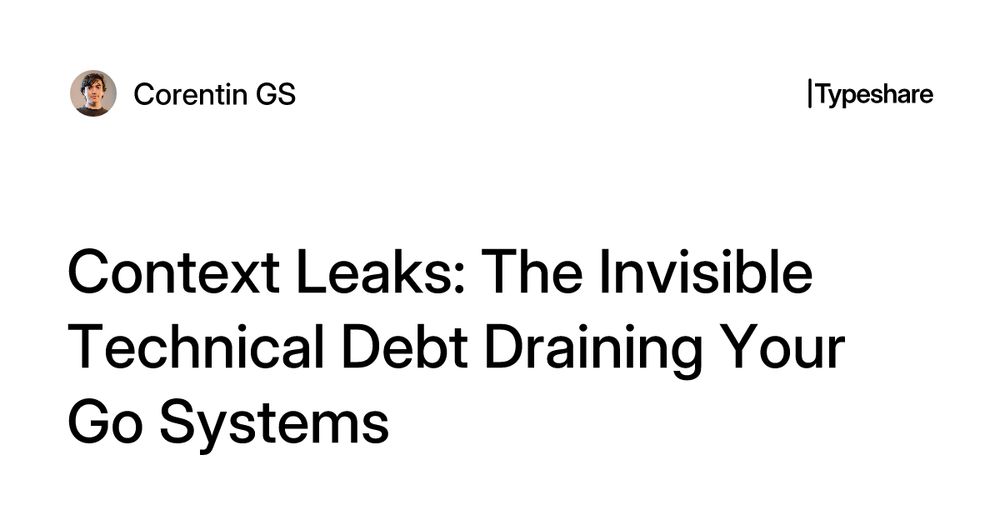
Read this and more on my Typeshare Social Blog: https://typeshare.co/corentings/posts/context-leaks-the-invisible-technical-debt-draining-your-go-systems-5065t
02.06.2025 19:00 — 👍 1 🔁 0 💬 0 📌 0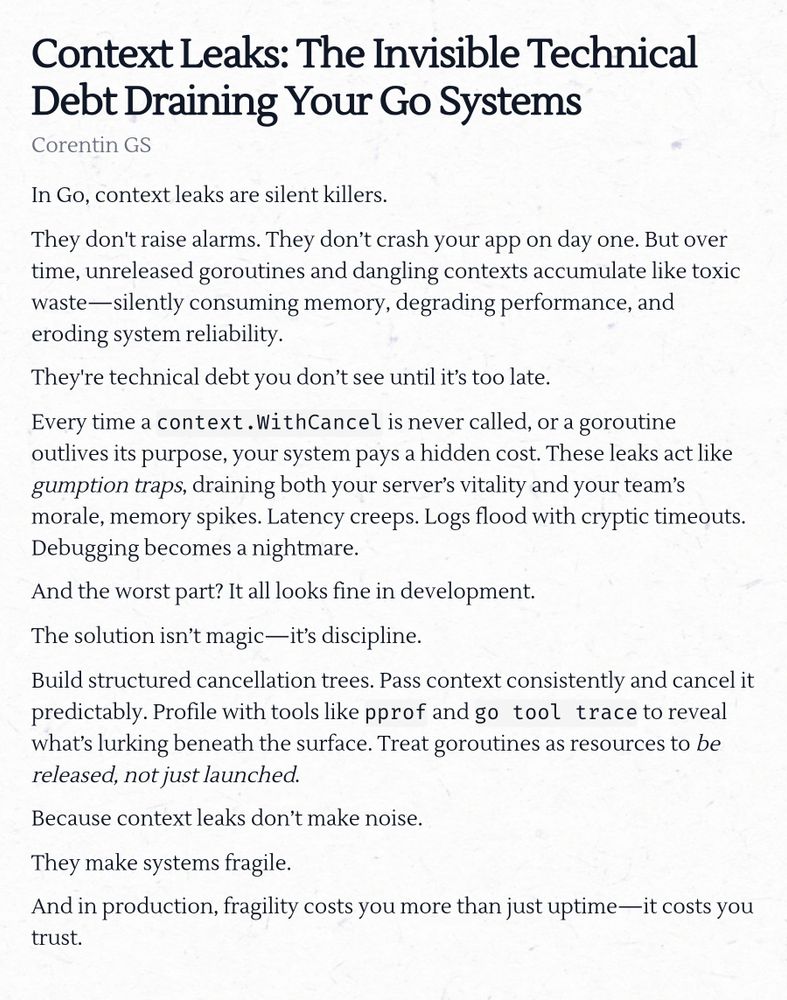
A screenshot essay titled 'Context Leaks: The Invisible Technical Debt Draining Your Go Systems.' The body discusses the dangers of context leaks in Go programming, which silently consume memory and degrade system performance without raising immediate alarms. It highlights the accumulated negative effects of unreleased goroutines and dangling contexts, comparing them to toxic waste. The importance of discipline in managing contexts and goroutines is emphasized, along with practical solutions like building structured cancellation trees and using profiling tools. The conclusion stresses that context leaks contribute to system fragility, ultimately costing trust in production environments.
Context leaks in Go are silent killers.
They don’t crash your app — they slowly drain it.
Unreleased goroutines = invisible technical debt.
Fix it before it breaks you.
#golang #backend
The truth?
Rust is brilliant. But Go is a cheat code.
• Idiomatic Go in 2 weeks
• Real-world output day one
• No fighting with the compiler
Want velocity? Go wins.
Rust’s complexity isn’t worth it for most teams.
#programming
Most devs learn MVC first.
Big mistake.
You learn structure before meaning.
DDD flips it:
• You code business, not boxes
• Features shrink from days to hours
• Logic finally has a home
Learn the language before the grammar.
#softwaredesign
You’re not building an OS.
You’re building CRUD APIs.
Stop over-engineering:
• Go gets new hires productive in days
• Rust drops team velocity by 50%
• Most apps don’t need a borrow checker
Choose speed over struggle.
#devlife
The most brilliant engineers I know don’t always pick the “best” tech.
They choose what yields the best results quickly.
• Go reads like English
• Devs ship in weeks
• Hiring is easy
• Teams move fast
Rust? It slows you down for marginal gains.
#softwareengineering
Choosing Rust for CRUD services is like buying a jet to drive to work.
Sure, it’s fast.
But you’ll burn time, money, and team morale just trying to park it.
Go is simpler, faster, and way more practical.
You can use the right tool for the real-world job.
#backend
But if you're building microservices, backend APIs, or distributed systems, Go or even C# tends to be a better choice. Simpler tooling, faster development, easier onboarding.
It's not about switching — it's about picking the right tool for the job.
Both languages have their place — it really depends on what you're building.
If you're writing an OS, a device driver, or anything performance-critical where memory safety without a GC matters — Rust (or even Zig) is a great fit.
I played a bit with it a few years ago but I don't have a lot of experience. Why?
29.05.2025 16:36 — 👍 0 🔁 0 💬 1 📌 0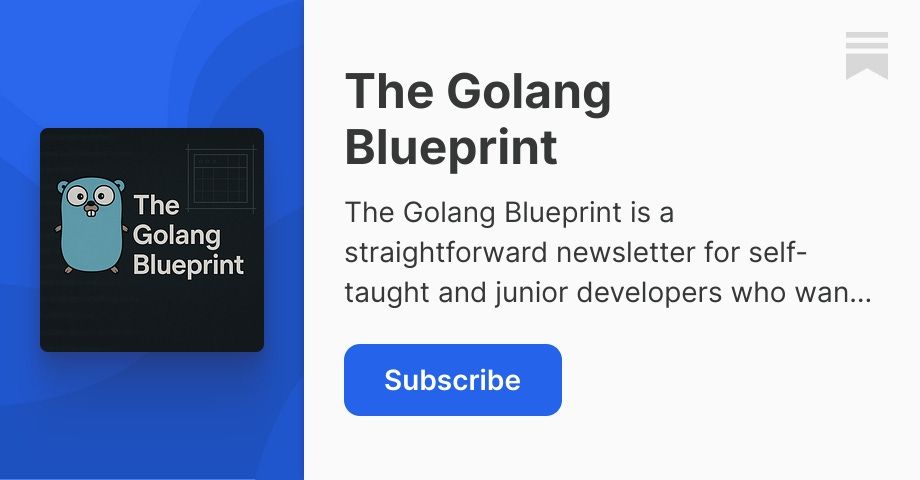
Sandbox mistakes don’t kill you.
They make you a real dev.
• Ask dumb questions
• Write ugly code
• Break your app
Then rebuild it stronger.
My journey through this cycle is in the newsletter today. #LearnToCode
https://thegolangblueprint.substack.com

The most humbling dev moment?
Passing all tests, then watching users get stuck.
• Tests ≠ UX
• Clever ≠ Clear
• Fancy ≠ Functional
These lessons hurt—but they stick.
The rest’s in this week’s newsletter. #SoftwareDev
https://thegolangblueprint.substack.com

You won't get good by watching tutorials.
I tried that.
Real growth came from building messy, chaotic projects and fixing what broke.
The sandbox is where you level up.
Full article drops in the newsletter. #CodingTips
https://thegolangblueprint.substack.com

I built and rebuilt the same app 5 times.
Not because I failed. Because I learned:
• Popular ≠ Practical
• 100% test coverage ≠ Usability
• Clever code ≠ Maintainable code
Each rewrite made me better.
Read how in today’s newsletter.
https://thegolangblueprint.substack.com

Most devs think mistakes mean failure.
But fighter pilots train in simulators. And we get sandboxes.
• Try fast
• Fail safely
• Learn deeply
This is the path to mastery.
Full story in this week’s newsletter. #SoftwareEngineering
https://thegolangblueprint.substack.com
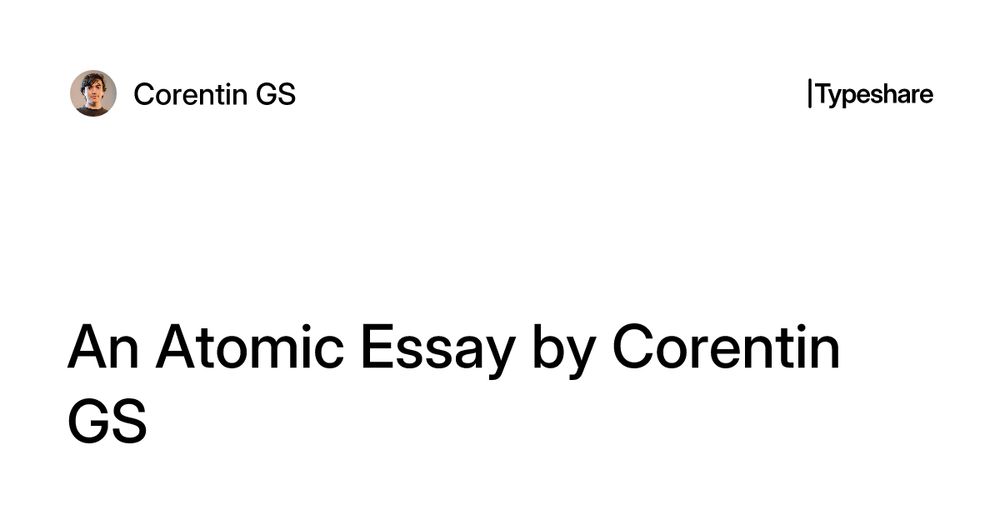
Read this and more on my Typeshare Social Blog: https://typeshare.co/corentings/posts/cmb6ae2jv003dl90dntewqz1i
27.05.2025 10:00 — 👍 1 🔁 0 💬 0 📌 0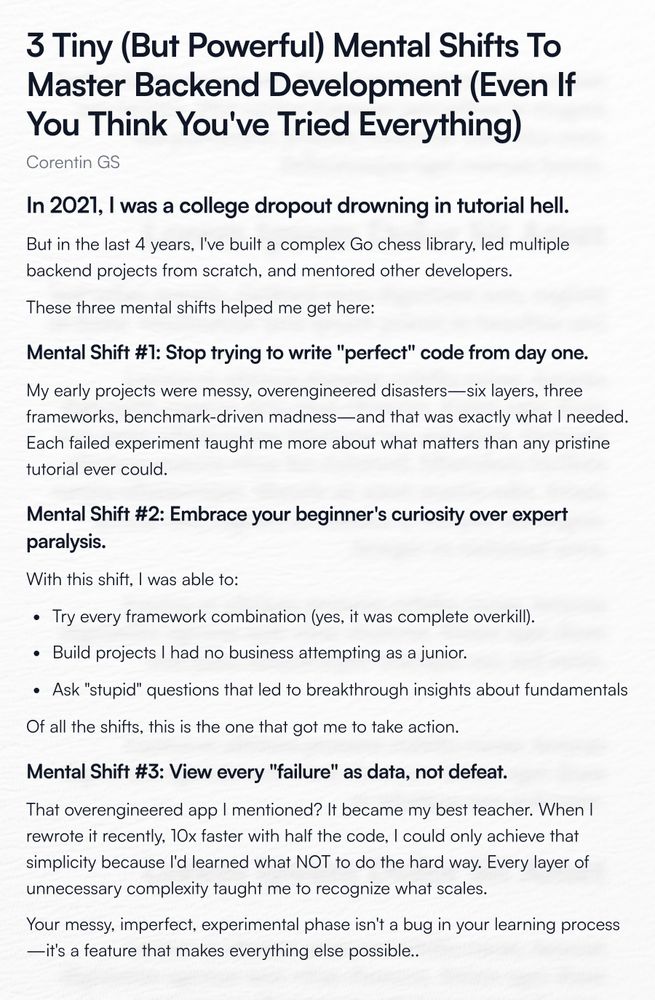
Screenshot essay titled '3 Tiny (But Powerful) Mental Shifts To Master Backend Development' detailing the author's journey from being a college dropout in 'tutorial hell' in 2021 to successfully building a complex Go chess library and leading backend projects. The essay outlines three mental shifts: 1) Stop aiming for 'perfect' code from the start, emphasizing the learning gained from failed projects. 2) Embrace beginner's curiosity to try new frameworks, tackle challenging projects, and ask questions that foster understanding. 3) View failures as valuable data rather than defeats, learning from complexities to achieve simplicity in code. The text encourages recognizing the 'messy phase' as a vital part of the learning process.
Stop trying to write "perfect" code as a beginner.
My early Go app: 6 layers, 3 frameworks, total mess
My rewrite: Just stdlib, 10x faster
Your "failures" teach more than tutorials.
#coding #webdev #buildinpublic
Want to build stunning CLI tools in Go?
Use Bubbletea.
• Beautiful text UIs
• Elegant architecture
• Fun to use
Make your terminal apps feel like magic.
#cli #golang #opensource
Tired of "works on my machine"?
Use Dev Containers.
• Instant dev environment setup
• Reproducible across the team
• All dependencies pre-installed
No more setup hell. Just code.
#devcontainers #docker #devops
The best messaging system I’ve used in 2025: NATS.
• Lightning-fast pub/sub
• Lightweight & reliable
• Supports clustering + persistence
Easier than Kafka. More robust than Redis. Built for scale.
#eventdriven #golang #scalability